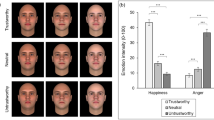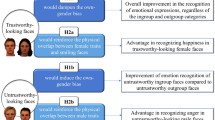Abstract
Past research demonstrates that individuals are relatively accurate at discriminating trustworthiness from untrustworthiness utilizing facial cues alone, and that this capacity is augmented for those with activated self-protection threat concerns. In the current study, we predicted that individuals who are dispositionally more wary of trusting others (those scoring high in dispositional distrust) would be more accurate at discriminating trustworthy from untrustworthy faces. Participants viewed a series of trustworthy and untrustworthy faces and indicated whether each target was trustworthy or untrustworthy; participants then completed a general distrust inventory. Consistent with predictions, those higher in dispositional distrust demonstrated more accurate discrimination of trustworthy and untrustworthy faces. Additionally, higher dispositional distrust was associated with a higher criterion for reporting targets as trustworthy. Interestingly, the higher discriminability and criterion of more distrustful individuals seemed to be driven by a tendency to make fewer false alarms (i.e., decisions to categorize an untrustworthy face as trustworthy), but not at the expense of fewer hits (i.e., decisions to categorize a trustworthy face as such). Despite the necessity of trust for social affiliation, these results suggest greater dispositional distrust may facilitate the identification of favorable conspecifics for social exchange and poor social exchange partners to be avoided.
Similar content being viewed by others
Notes
As is common in signal detection analyses, adjustments to the data were made to address the problem of empty cells: 0 % was adjusted to 5 %, and 100 % was adjusted to 95 % (see Hugenberg et al. 2007). Alternate adjustments yielded nearly identical results.
References
Balliet, D., Mulder, L. B., & Van Lange, P. A. (2011). Reward, punishment, and cooperation: a meta-analysis. Psychological Bulletin, 137, 594–615.
Cesarini, D., Dawes, C. T., Fowler, J. H., Johannesson, M., Lichtenstein, P., & Wallace, B. (2008). Heritability of cooperative behavior in the trust game. Proceedings of the National Academy of Sciences, 105, 3721–3726.
Chang, L. J., Doll, B. B., van’t Wout, M., Frank, M. J., & Sanfey, A. G. (2010). Seeing is believing: trustworthiness as a dynamic belief. Cognitive Psychology, 61, 87–105.
Cialdini, R. B., Kallgren, C. A., & Reno, R. R. (1991). A focus theory of normative conduct: a theoretical refinement and reevaluation of the role of norms in human behavior. Advances in Experimental Social Psychology, 24, 201–234.
Cosmides, L., & Tooby, J. (1989). Evolutionary psychology and the generation of culture, part II: case study: a computational theory of social exchange. Ethology and Sociobiology, 10, 51–97.
Cotterell, N., Eisenberger, R., & Speicher, H. (1992). Inhibiting effects of reciprocation wariness on interpersonal relationships. Journal of Personality and Social Psychology, 62, 658–668.
Cottrell, C. A., Neuberg, S. L., & Li, N. P. (2007). What do people desire in others? A sociofunctional perspective on the importance of different valued characteristics. Journal of Personality and Social Psychology, 92, 208–231.
De Backer, C. J. S., Larson, C., Fisher, M. L., McAndrew, F. T., & Rudnicki, K. (2016, ahead of print). When strangers start to gossip: investigating the effect of gossip in a prisoner’s dilemma game. Evolutionary Psychological Science.
De Cremer, D., & Tyler, T. R. (2007). The effects of trust in authority and procedural fairness on cooperation. Journal of Applied Psychology, 92, 639–647.
De Cremer, D., Snyder, M., & Dewitte, S. (2001). ‘The less I trust, the less I contribute (or not)?’ The effects of trust, accountability and self‐monitoring in social dilemmas. European Journal of Social Psychology, 31, 93–107.
Delton, A. W., Krasnow, M. M., Cosmides, L., & Tooby, J. (2011). Evolution of direct reciprocity under uncertainty can explain human generosity in one-shot encounters. Proceedings of the National Academy of Sciences, 108, 13335–13340.
Feinberg, M., Willer, R., Stellar, J., & Keltner, D. (2012). The virtues of gossip: reputational information sharing as prosocial behavior. Journal of Personality and Social Psychology, 102, 1015–1030.
Haselhuhn, M. P., & Wong, E. M. (2011). Bad to the bone: facial structure predicts unethical behaviour. Proceedings of the Royal Society of London B: Biological Sciences, 279, 571–576.
Haselton, M. G., & Nettle, D. (2006). The paranoid optimist: an integrative evolutionary model of cognitive biases. Personality and Social Psychology Review, 10, 47–66.
Hugenberg, K., Miller, J., & Claypool, H. M. (2007). Categorization and individuation in the cross-race recognition deficit: toward a solution to an insidious problem. Journal of Experimental Social Psychology, 43, 334–340.
Krumhuber, E., Manstead, A. S., Cosker, D., Marshall, D., Rosin, P. L., & Kappas, A. (2007). Facial dynamics as indicators of trustworthiness and cooperative behavior. Emotion, 7, 730.
Kurzban, R., & Houser, D. (2001). Individual differences in cooperation in a circular public goods game. European Journal of Personality, 15, S37–S52.
Maloney, P., Grawitch, M. J., & Barber, L. K. (2011). Strategic item selection to reduce survey length: reduction in validity? Consulting Psychology Journal: Practice and Research, 63, 162–175.
Mealey, L., Daood, C., & Krage, M. (1996). Enhanced memory for faces of cheaters. Ethology and Sociobiology, 17, 119–128.
Rempel, J. K., Holmes, J. G., & Zanna, M. P. (1985). Trust in close relationships. Journal of Personality and Social Psychology, 49, 95–112.
Rezlescu, C., Duchaine, B., Olivola, C. Y., & Chater, N. (2012). Unfakeable facial configurations affect strategic choices in trust games with or without information about past behavior. PloS One, 7, e34293.
Sacco, D. F., Brown, M., & Lustgraaf, C. J. N. (2016a). The relation between individual differences in fundamental social motives and adaptive face perceptions. Human Ethology Bulletin. 31, 25-33.
Sacco, D. F., Brown, M., Lustgraaf, C. J. N., & Young, S. G. (2016b). Women’s dangerous world beliefs predict more accurate discrimination of affiliative cues in faces. Evolutionary Behavioral Sciences.
Sacco, D. F., Merold, S. J., Lui, J. H., Lustgraaf, C. J. N., & Barry, C. T. (2016c). Social and emotional intelligence moderate the relationship between psychopathy traits and social perception. Personality and Individual Differences, 95, 95–104.
Schwartz, S. H., & Bardi, A. (2001). Value hierarchies across cultures taking a similarities perspective. Journal of Cross-Cultural Psychology, 32, 268–290.
Slepian, M. L., Young, S. G., Rule, N. O., Weisbuch, M., & Ambady, N. (2012). Embodied impression formation: social judgments and motor cues to approach and avoidance. Social Cognition, 30, 232–240.
Stirrat, M., & Perrett, D. I. (2010). Valid facial cues to cooperation and trust male facial width and trustworthiness. Psychological Science, 21, 349–354.
Trivers, R. L. (1971). The evolution of reciprocal altruism. Quarterly Review of Biology, 35–57.
Yamagishi, T. (1986). The provision of a sanctioning system as a public good. Journal of Personality and Social Psychology, 51, 110.
Yamagishi, T., & Yamagishi, M. (1994). Trust and commitment in the United States and Japan. Motivation and Emotion 18, 129–166.
Young, S. G., Slepian, M. L., & Sacco, D. F. (2015). Sensitivity to perceived facial trustworthiness is increased by activating self-protection motives. Social Psychological and Personality Science, 6, 607–613.
Author information
Authors and Affiliations
Corresponding author
Rights and permissions
About this article
Cite this article
Calabrese, J.R., Brown, M. & Sacco, D.F. Casting a Wary Eye: Individuals Higher in Dispositional Distrust Demonstrate More Accurate Discrimination of Trustworthy and Untrustworthy Faces. Evolutionary Psychological Science 3, 34–39 (2017). https://doi.org/10.1007/s40806-016-0072-6
Published:
Issue Date:
DOI: https://doi.org/10.1007/s40806-016-0072-6




